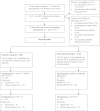Effects of cardiovascular disease risk communication for patients with type 2 diabetes on risk perception in a randomized controlled trial: the @RISK study
- PMID: 22923669
- PMCID: PMC3507585
- DOI: 10.2337/dc11-2130
Effects of cardiovascular disease risk communication for patients with type 2 diabetes on risk perception in a randomized controlled trial: the @RISK study
Abstract
Objective: Patients with type 2 diabetes mellitus (T2DM) underestimate their risk of developing severe complications, and they do not always understand the risk communication by their caregivers. The aim of this study was to investigate the effects of an intervention focused on the communication of the absolute 10-year risk of developing cardiovascular disease (CVD) in patients with T2DM.
Research design and methods: A randomized controlled trial was performed in T2DM patients newly referred to the Diabetes Care System (DCS) West-Friesland, a managed-care system in the Netherlands. The intervention group (n = 131) received a six-step CVD risk communication. Control subjects (n = 130) received standard managed care. The primary outcome measure was appropriateness of risk perception (difference between actual CVD risk calculated by the UK Prospective Diabetes Study risk engine and risk perception). Secondary outcome measures were illness perceptions, attitude and intention to change behavior, satisfaction with the communication, and anxiety and worry about CVD risk. Patients completed questionnaires at baseline, at 2 weeks (immediately after the intervention), and at 12 weeks.
Results: Appropriateness of risk perception improved between the intervention and control groups at 2 weeks. This effect disappeared at 12 weeks. No effects were found on illness perceptions, attitude and intention to change behavior, or anxiety and worry about CVD risk. Patients in the intervention group were significantly more satisfied with the communication.
Conclusions: This risk communication method improved patients' risk perception at 2 weeks but not at 12 weeks. Negative effects were not found, as patients did not become anxious or worried after the CVD risk communication.
Figures


References
-
- Waldron CA, van der Weijden T, Ludt S, Gallacher J, Elwyn G. What are effective strategies to communicate cardiovascular risk information to patients? A systematic review. Patient Educ Couns 2011;82:169–181 - PubMed

